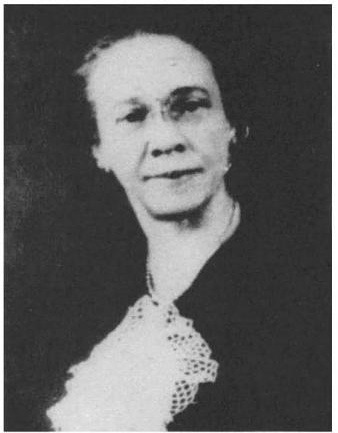

Partner Lucy Diggs Slowe
Queer Places:
1256 Kearny St NE, Washington, DC 20017, USA
Emerson College, 120 Boylston St, Boston, MA 02116, Stati Uniti
Woodlawn Cemetery, 4611 Benning Rd SE, Washington, DC 20019, Stati Uniti
 Mary P.
"Mamie" Burrill (August 1881 – March 13, 1946) was an early
20th-century
African-American female playwright and educator who also inspired
Willis Richardson and other students to write plays. African American poet
Angelina Weld Grimké, the
grandniece of abolitionists Sarah and Angelina Grimké, in the last decade of
the nineteenth century formed a romantic friendship but later obscured her
love for women. As a member of the middle class, Grimké's friendship with her
school friend Mamie Burrill followed the pattern common among white
middle-class women. In 1896 Burrill wrote to Grimké: “Could I just come to
meet thee once more, in the old sweet way, just coming at your calling, and
like an angel bending o'er you breathe into your ear, ‘I love you.'” Grimké,
later that year, expressed her own longing: “Oh Mamie if you only knew how my
heart beats when I think of you and it yearns and pants to gaze, if only for
one second upon your lovely face.”
Mary P.
"Mamie" Burrill (August 1881 – March 13, 1946) was an early
20th-century
African-American female playwright and educator who also inspired
Willis Richardson and other students to write plays. African American poet
Angelina Weld Grimké, the
grandniece of abolitionists Sarah and Angelina Grimké, in the last decade of
the nineteenth century formed a romantic friendship but later obscured her
love for women. As a member of the middle class, Grimké's friendship with her
school friend Mamie Burrill followed the pattern common among white
middle-class women. In 1896 Burrill wrote to Grimké: “Could I just come to
meet thee once more, in the old sweet way, just coming at your calling, and
like an angel bending o'er you breathe into your ear, ‘I love you.'” Grimké,
later that year, expressed her own longing: “Oh Mamie if you only knew how my
heart beats when I think of you and it yearns and pants to gaze, if only for
one second upon your lovely face.”
Mary Powell Burrill was born in August 1881 in Washington, D.C., the daughter of John H. and Clara E. Burrill.[1][2] In 1901, she graduated from M Street High School (later Dunbar High School) in Washington, D.C.. When her family moved to Boston, she attended Emerson College of Oratory (later Emerson College), where she received a diploma in 1904.[3]
In 1919, two of her best known plays were published. They That Sit in Darkness was published in Margaret Sanger's progressive Birth Control Review, a monthly publication advocating reproductive rights for women. The other play, Aftermath, was published in Liberator, edited by socialist Max Eastman.[2][3] Burrill understood her plays as deliberate acts of political protest advocating radical stances on issues of race and gender.[4]
The story of They That Sit in Darkness focuses on the effects of having multiple children to a young mother. Despite repeated warnings from midwives for the mother to "be careful" she continues to have children with dire consequences.[5] Burrill took to the convention of the one-act form as it flowered in the contemporaneous productions of the Provincetown Players and Washington Square Players and as it has been hailed as a prime source of modern American drama.[6] Sandra L. West of Virginia Commonwealth University in a brief essay on Burrill described the work as controversial for its time because the play advocated birth control as a means to escape poverty long before women were given reproductive rights.[2]
Aftermath is set in rural South Carolina and involves a soldier who discovers that his father has been lynched after he returns from fighting overseas. It was produced by New York City's Krigwa Players in 1928.[2][7] In Aftermath (1919), Mary Burrill presents the character John as an example of the assertive black male who selflessly and fearlessly confronts racial oppression.[8]
For many years, Burrill taught English, speech and drama at Dunbar High School. While there, she encouraged several of her students to write plays. One of her prized students was Willis Richardson, who would later become the first African-American dramatist to have a play produced on Broadway. Another was May Miller, who published her first play, Pandora's Box, while still a student at Dunbar.[3]
For a time in the 1920s and '30s Burrill lived with Lucy Diggs Slowe, the first Dean of Women at Howard University. Slowe and Burrill met in 1912 when Slowe was teaching English in Baltimore and Burrill was teaching the same subject at Dunbar High in Washington. When Slowe moved to DC to teach at Armstrong Manual Training Academy, she and Burrill moved in together, first at 1758 T Street NW, then at 1744 K Street NW. When Slowe was appointed Dean of Women at Howard they decided to buy a house together at 1256 Kearny Street NE in Brookland. Before they did that, Slowe won an agreement from J. Stanley Durkee, the last white president of Howard, that she wouldn’t be required to live on campus. Lucy Diggs Slowe died in 1937 of kidney disease. Mary Burrill was shattered and moved out of the house to an apartment near Howard. Burrill kept Slowe’s picture on her piano, next to a vase filled with white carnations.[10]
Upon her retirement from teaching in 1944, Burrill moved to New York City, where she died on March 13, 1946.[3] She is buried at Woodlawn Cemetery in Washington D.C.[9]
My published books: